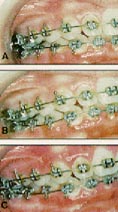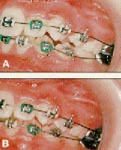TECHNIQUE CLINIC
A Practical Method of Correcting Posterior Open Bite
The posterior segments frequently must be extruded to level the occlusal plane, to close a posterior open bite, or to settle the teeth in the finishing stage of treatment. Intermaxillary vertical elastics >("W", "M", box, etc.) are commonly used with or without archwires or sectional wires to extrude posterior teeth.
A drawback of this technique is that bicuspids are sometimes bonded before they are completely erupted, in an attempt to begin treatment as early as possible. If the bicuspid brackets are placed too occlusally, they must be rebonded after the teeth have been extruded, or 2nd-order bends must be placed.
Another way to extrude teeth is to place the archwire--preferably a resilient wire at first--outside the bracket, rather than in the bracket slot (Fig. 1). This works particularly well with brackets that have ball hooks (Fig. 2).
One caveat is that this technique will incline the teeth lingually (as will vertical elastics when used without archwires). It is possible that an archwire with 2nd-order bends might be required to correct these lingual inclinations. However, it is much easier to place such an archwire, and to use a heavier wire, once the teeth have been extruded.






